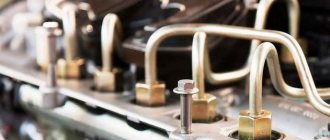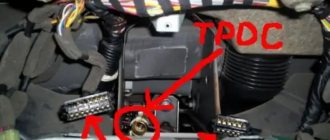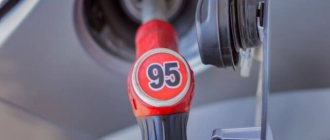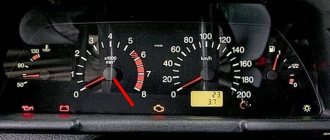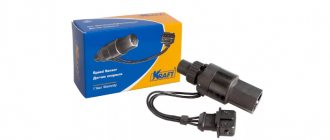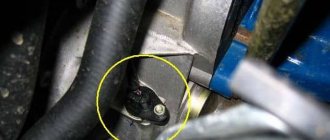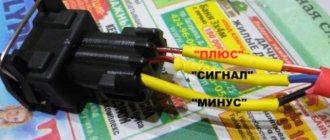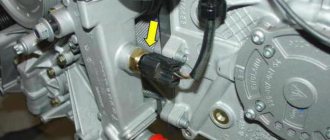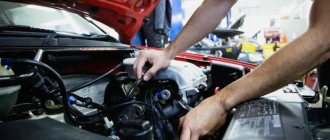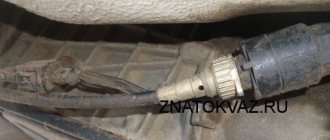Jerking when starting to move
At the moment the movement begins, the limiting case of a jerk—failure—most often occurs.
The most unpleasant sensations are associated precisely with the delay in the engine's response to pressing the accelerator pedal.
Sometimes the engine even stalls.
A jerk occurs at the moment the throttle valve begins to open, when, based on a signal from the throttle position sensor, the ECU determines the moment of transition from idle mode to load mode and must increase the amount of fuel supplied through the injectors.
If the pressure in the fuel line is insufficient (even if the injection duration is increased), there is not enough fuel for a smooth start.
Jerks during acceleration
The cause of jerking during acceleration may be, as in the previous case, insufficient fuel pressure in the fuel line.
The electronic engine control unit, having received a signal from the throttle position sensor about the intensive opening of the throttle at a large angle, strives to maximize the fuel supply, but due to the reduced fuel pressure it is not able to do this.
The reasons for this phenomenon and the method of verification are the same as in the previous case.
Jerks during steady motion
Such jerking is most often caused by a malfunction of the ignition system. Diagnosis and repair are required.
Along the way, you can try the following on your own:
– carefully inspect the engine compartment.
Turn off the ignition and check that the wiring harness connectors are securely attached to the ignition coils.
Start the engine and listen to its operation: the crackling sound when the high voltage breaks down to ground is weak, but distinct.
In complete darkness, the spark during breakdown is clearly visible;
– replace spark plugs regardless of their condition and mileage.
Pay attention to the condition of the spark plugs: if they are abnormal, the engine or its systems may need to be repaired.
A specific cause of jerking during steady motion of a car with an injection engine may be sensor failure
throttle position. Additional symptoms confirming the malfunction of this sensor are:
– uneven operation of the engine at idle;
– reduction in maximum engine power.
The sensor is non-separable and therefore cannot be repaired. If a sensor malfunction is detected, it is replaced as an assembly.
The car accelerates poorly
There are many reasons for the deterioration of dynamics, the main ones can be defined as follows.
1. Engine malfunction: decreased compression in one or more cylinders, leakage of additional air into the engine intake tract.
Coking of the exhaust system or damage to the exhaust gas converter (if the vehicle is equipped with a catalytic converter).
2. Malfunction of the power supply system: clogged injectors and fuel filter, hoses of the fuel supply system. Insufficient fuel pump supply. Use of low quality fuel.
3. Malfunction of the ignition system: failure of the spark plug, breakdown of the high-voltage circuit of the system.
4. Engine management system malfunction: failure of system sensors.
If any sensor fails, the electronic control unit switches to working according to a backup program, allowing you to get to a garage or car service center, but at the same time the power and economic characteristics of the engine are reduced.
5. Clutch slippage due to wear or misadjustment.
6. Malfunction of the brake system: braking of one or more wheels while driving, incorrect adjustment of the parking brake.
7. Insufficient air pressure in tires.
8. Vehicle overload. Full diagnostics of the car should be carried out by highly qualified technicians using special diagnostic equipment, so contact a car service center.
You can do the following work yourself
1. Check and adjust tire pressure to normal.
2. Check the operation of the service brake system and parking brake. It is not necessary to remove the wheels for this.
Find a flat section of the road and, in dry, windless weather, conduct a test run to determine the vehicle's run-out.
The car must be fully fueled, with only the driver in the cabin. Accelerate the car to 50 km/h, level out the speed, then switch off the gear and coast until it comes to a complete stop.
Do another run in the opposite direction. The run-out should be about 500 m.
3. Check the operation of the ignition system as described above.
4. Check clutch operation. The initial check is carried out on a level area free of obstacles.
Set the accelerator pedal to a higher idle speed - approximately 1500 min-1.
Brake the car with the parking brake.
Depress the clutch and engage first gear.
Then begin to smoothly release the clutch pedal.
If the engine stalls, the clutch is working properly and is not slipping.
If the engine does not stall, the clutch is worn out, it must be replaced or the drive adjusted.
5. Check the serviceability of the engine control system.
The engine stalled while driving
Sooner or later, every driver may find himself in a situation where a car, which just a few moments ago obeyed all commands, suddenly stops responding to pressing the accelerator pedal, and red lights light up on the dashboard.
The engine has stopped working and the car is losing speed.
There are two main reasons:
– the ignition system does not work;
– the power supply system does not work.
First, determine whether there is gasoline in the tank.
Turn on the ignition and look at the fuel gauge.
If the yellow fuel reserve warning light does not light up and the indicator arrow shows the presence of fuel, we can assume that there is gasoline in the tank.
Open the hood and carefully inspect the engine compartment. Pay attention to the integrity of all units.
Check if all the wires are in place, if there are any torn, burnt or damaged insulation.
Inspect the gasoline hoses, engine fuel line and fuel filter (installed under the bottom of the car near the rear of the right side sill) for any gasoline leaks.
If gasoline is leaking, do not start the engine under any circumstances until the problem is completely eliminated!
Inspect the cooling system expansion tank to see if coolant has leaked. Also check the oil level in the engine crankcase.
If everything is in order, proceed to check the ignition and power systems described earlier, but first check the condition of the timing belt.
If the belt is broken, the engine will not start for no apparent reason.
Jerks when driving a Lada Priora car
In relation to a car, a jerk is a short-term spontaneous change in the speed of the engine crankshaft, regardless of the position of the accelerator pedal.
In everyday use, as a rule, there are a series of jerks. The extreme case of a jerk is a failure - a noticeable delay in the engine's response to pressing the accelerator pedal.
Conventionally, three types of jerks can be distinguished:
- at the moment of starting movement;
— during acceleration;
— with steady motion, i.e. with the accelerator pedal in constant position.
To determine the causes of jerks when driving a car with an injection engine, special diagnostic equipment is required, so in this case we recommend contacting a service that specializes in repairing fuel injection systems.
As practice shows, in most cases jerking is caused by insufficient fuel pressure in the fuel rail, malfunction of the throttle position sensor or mass air flow sensor.
If you have some skills, you can determine the cause of jerking yourself.
Prevention is better than repair
But first of all, it is necessary to find an answer to the question of why the VAZ-21124 jerks during acceleration. On the face of it, it doesn't seem like a very ordinary question. But in fact, such twitching becomes not funny at all. You start to feel especially creepy when the VAZ-21124 jerks during acceleration and the check light comes on. Trouble has become reality.
It has long been known that any breakdown is easier to prevent than to fix. Therefore, try to pay more attention to your vehicle while driving. And here a problem arises: not every driver can feel the car and determine the cause in time.
You should immediately decide on the sequence of actions:
- Checking the car for twitching while idling is unacceptable. This should only be done when moving.
- The check should begin on the smoothest and least dangerous section of the route, where there is no heavy traffic.
- To check, start shifting gears one by one by pressing the gas pedal on each gear.
- If the vehicle begins to jerk without your participation, therefore, the root cause of the problem must be sought in this problem.
How to understand why failure occurs when you press the accelerator
Often, the source of the problem is indicated by additional signs of a malfunction - for example, a “reluctant” engine start “on cold”, a general decrease in power (even before failures appear), increased fuel consumption. A very important criterion is when the problem manifests itself. If you notice that the engine spins up nonlinearly, as if there is a counterforce preventing it from gaining speed, most likely the reason is a clogged fuel or air filter. If the car “jerks” during acceleration with a smooth opening of the throttle, and, when pressed more intensely, it suddenly “shoots” - the jerks are associated with a lack of fuel. Dips during over-throttle and prolonged pressing and holding of the gas pedal, multiplied by difficult starting of a cold engine, indicate a malfunction of one or more spark plugs (and their coils).
Flooded or faulty spark plugs can also cause the gas pedal to fail.
The spark plugs that come with the car from the factory are more durable than most commercially available consumables, so the second and subsequent replacements are recommended to be done at shorter intervals.
Sometimes the problems of loss of throttle response, jerking, stepwise acceleration during acceleration are not at all related to the operation of the engine. On cars with automatic transmission, this is how severe wear appears. You will notice it when switching during acceleration - first a second delay without reaction to the gas pedal, then a push and acceleration. In cars with gas equipment, such a reaction to gas begins to occur when the gas reducer or its sensor breaks down. At the same time, the car begins to consume two to three times more gas. In diesel engines, an adequate response to vigorous pressing of the gas pedal is greatly impaired by refueling with low-quality fuel with a high sulfur content, or with a type of diesel fuel that does not correspond to the season.
Featured Posts
CDA
- Newbie
- Users
- 1
- 12 publications
- Car make: Lada
- From:Tolyatti
A friend has a problem: My IAC is fine. The car jerks while driving. Sometimes. I checked the high-voltage wires and spark plugs. There is no water in the tank. What's wrong with my Priora?
I don’t understand what’s going on myself. What could be the problem? write, guys! Thank you in advance!
Vans
- Advanced
- Advanced Members
- 3
- 198 publications
- Car brand:-
- From:Togliatti
If the car is under warranty, let it go for diagnostics. The car just won't jerk. Alternatively, gasoline is crap.
DEN150278
- Advanced
- Advanced Members
- 6
- 158 publications
- Car make:21144, 1117
- From: KIMRY
Checked high voltage wires and spark plugs
there are no high voltage wires
